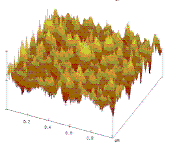Chemical and Biomolecular Research Papers -- Faculty Authors Series

Anuradha Subramanian Publications
Document Type
Article
Date of this Version
July 2007
Abstract
Spectroscopic ellipsometry (SE) is a non-contact and a non-destructive optical technique used in characterization of thin films. It is widely used to determine optical constants, thickness in multilayer stacks and microstructure (voids, alloy fraction, or mixed phase composition). This paper reports on a systematic investigation of the optical properties of two different kinds of silane compounds: 3-aminopropyltriethoxysilane (APTES) and 3-glycidoxypropyltriethoxy-silane (GPS) as well as for immunoglobulin G (IgG) attached to these modified samples using vacuum ultraviolet spectroscopic ellipsometry (VUV-SE). VUV-SE is a newly developed technique and used to evaluate the strength and energy of the interband electronic excitations/transitions in these biofilms. The shorter wavelengths of VUV-SE increase sensitivity for detection of extremely thin adsorbed films at an interface (<10 nm) and accurately determine optical properties of biological interactions/ moieties on the surface. A Cauchy dispersion model was used to determine layer thicknesses in multilayer stacks and adsorption was accounted by including Gaussian shaped oscillators in the optical model. No measurable optical anisotropy is found for these films. The dielectric properties of the adsorbed films are reported in the 0.73–9.43 eV optical range.


Comments
Published in Materials Science and Engineering: B (2007); doi:10.1016/j.mseb.2007.11.034. Copyright © 2007 Elsevier B.V. Used by permission. http://www.science-direct.com/science/journal/09215107